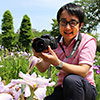[Lesson 6] Utilising the Compression Effect and Large Bokeh of Telephoto Lenses
Of the wide variety of interchangeable lenses available, telephoto lenses allow us to zoom in and capture a large view of a distant object. In this article, I will focus on these lenses and explain the basic techniques to make the best use of them. (Reported by: Yutaka Tanekiyo)

Pages: 1 2
Telephoto lenses offer more than just a large view of the subject
The world that we see through a telephoto lens is completely different from what we see through our naked eye. Some of the representative characteristics of this lens type include a magnification effect that makes a distant subject appear much closer than it really is, and a compression effect that seems to narrow the distance between a distant and a nearby object. Yet another noteworthy feature is the shallower depth of field as we zoom in further, which enables bokeh effect to be created more easily in the background. Taking these properties into consideration, it is therefore an understatement to say that a telephoto lens is simply a lens for capturing distant objects. Instead, why not understand the effects that can be created by a telephoto lens and make effective use of them in your photographic works?
1. I wanted to capture narcissus blossoms under the setting sun

A bed of narcissus flowers in their full bloom. I wanted to capture the flowers with light from the setting sun in the background.
2. Using a standard zoom creates a cluttered impression

[Equivalent to 88mm in 35mm format]
I started by taking a shot using the EF-S18-55mm f/3.5-5.6 IS STM. At a focal length of 55mm (88mm in 35mm-equivalent terms), a wide area was captured and the main theme was not well defined. I could not get any closer to the flowers, so I decided to switch to a telephoto lens.
3. The main subject stands out after I switched to a telephoto lens

[Equivalent to 400mm in 35mm format]
Here, I captured a shot at the lens' telephoto end of focal length 250mm (400mm in 35mm-equivalent terms). Although the main subject stands out in this photo, the woods in the distant background make the entire image appear dark. I would need to adjust the camera's angle and position to capture a brighter background.
4. Done! Captured the perfect shot

By changing the direction in which the lens was pointing, I was able to capture both the narcissus as well as the glow of the setting sun which brightened the background. Using a telephoto lens with a shallow depth of field allows us to create a large bokeh effect in both the flowers and the background.
[Tip] A slight shift in the camera angle can significantly change how the background appears

As a telephoto lens has the effect of bringing a distant object closer, a slight adjustment of the camera angle or position will have a significant impact on how the background turns out. The key to photographing with a telephoto lens, therefore, is to check what is being captured in the background before deciding on the camera position or angle.
Scenes where you'll want to use telephoto lens
There are many scenes where a telephoto lens can be put to good use, such as natural landscapes, sports, animals, and vehicles. In the following, let us look at some examples to see how we can utilise telephoto lens to bring out the main theme and convey the photographic intention.
Zoos and aquariums

A baby seal lying on its mother's back. Here, I cropped away most part of the background and blurred it to prevent the water tanks in the zoo from creating a cluttered impression. Doing so naturally brings out the main attraction of the photo—the face of the sleeping seal.
Dynamic natural landscapes

A telephoto lens also makes a powerful tool when we photograph waterfalls that are hard to get close to. Instead of capturing the entire landscape, I focused on the part where the water flow was most distinctive and composed a vertical shot. Thanks to the compression effect, I was able to produce a dynamic shot of the waterfall by capturing a large view of the plunge pool at the far end.
A carpet of tiny flowers

A telephoto lens is also effective for capturing a carpet of tiny flowers. By setting the lens to the telephoto end and establishing focus at the centre of the composition, we can blur both the foreground and the background to highlight the flowers, which form the image centrepiece.

Born in 1982 in Osaka. After graduating from the Faculty of Foreign Studies at Kyoto Sangyo University as a German language major, Tanekiyo worked as an assistant to Toshinobu Takeuchi, after which he became an independent photographer.

A monthly magazine that believes that enjoyment of photography will increase the more one learns about camera functions. It delivers news on the latest cameras and features and regularly introduces various photography techniques.
Published by Impress Corporation


































